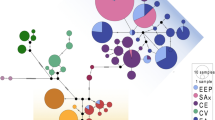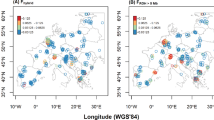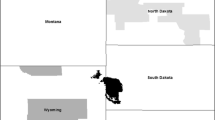Abstract
The muskox Ovibos moschatus (Zimmerman 1780) is a specialised arctic mammal with a highly fragmented circumpolar distribution, with native populations in Canada and east Greenland and introduced populations in west Greenland, Alaska, Siberia and Eurasia. In 1971, five O. moschatus individuals from an introduced population in Norway migrated to Sweden. After a peak population of 36 individuals in the mid-1980s, the Swedish population now numbers seven individuals, making it vulnerable to both demographic and genetic stochasticity (i.e. inbreeding). Here, we analyse genetic variation among native and introduced populations of O. moschatus to evaluate the genetic effect of sequential founder events in this species. Our results show that genetic variation among native and introduced O. moschatus populations do not conform entirely to the expectations from sequential founder events, most likely because of random processes associated with introduction. In the Swedish population, a calf resulting from the mating of a wild cow and a captive Greenlandic bull contributes significantly to the current genetic variation. Thus, even a single outbreeding event may, at least momentarily, increase the genetic variation and potentially prevent inbreeding depression. Our results should aid the long-term preservation of O. moschatus in Sweden and Europe.




Similar content being viewed by others
References
Alendal E (1974) The history of muskoxen in Sweden. Fauna Flora 2:41–46 [In Swedish]
Andersson A-C, Andersson S, Lönn M (2007) Genetic variation in wild plants and animals in Sweden. Naturvårdsverket, Rapport 5712:1–179 (in Swedish)
Barr W (1991) Back from the brink: the road to muskox conservation in the Northwest Territories. Arctic Institute of North America, Komatik series 3, University of Calgary, pp 1–127
Belkhir K, Borsa P, Chikhi L, Raufaste N, Bonhomme F (2004) GENETIX 4.05, logiciel sous Windows TM pour la génétique des populations. Laboratoire Génome, Populations, Interactions, CNRS UMR 5171, Université de Montpellier II, Montpellier, France
Bennike O, Andreasen C (2005) New dates of musk-ox (Ovibos moschatus) remains from northwest Greenland. Polar Rec 41:125–129
Broders HG, Mahoney SP, Montevecchi WA, Davidson WS (1999) Population genetic structure and the effect of founder events on the genetic variability of moose, Alces alces, in Canada. Mol Ecol 8:1309–1315
Campos PF, Willerslev E, Sherb A, Orlando L, Axelsson E, Tikhonov A, Aaris-Sørensen K, Greenwood AD, Kahlke R-D, Kosintsev P, Krakhmalnaya T, Kuznetsova T, Lemey P, MacPhee R, Norris CA, Shepherd K, Suchard MA, Zazula GD, Shapiro B, Gilbert MTP (2010) Ancient DNA analyses exclude humans as the driving force behind late Pleistocene musk ox (Ovibos moschatus) population dynamics. P Natl Acad Sci USA 107:5675–5680
Cassinello J (2005) Inbreeding depression on reproductiove performance and survival in captive gazelles of great conservation value. Biol Cons 122:453–464
Clegg SM, Degnan SM, Kikkawa J, Moritz C, Estoup A, Owens IPF (2002) Genetic consequences of sequential founder events by an island-colonizing bird. P Natl Acad Sci USA 99:8127–8132
Coltman DW, Bowen WD, Wright JM (1998) Birth weight and neonatal survival of harbour seal pups are positively correlated with genetic variation measured by microsatellites. P Roy Soc Lond B BIO 265:803–809
Coltman DW, Pilkington JG, Smith JA, Pemberton JM (1999) Parasite-mediated selection against inbred Soay sheep in a free-living, island population. Evolution 53:1259–1267
DeYoung RW, Honeycutt RL (2005) The molecular toolbox: genetic techniques in wildlife ecology and management. J Wildl Manage 69:1362–1384
Ericson M (2002) [Muskoxen. A local management plan to improve the possibility for muskoxens to survive in the Swedish mountain range]. Projekt Myskoxe, Framtidsfjäll 2000 (in Swedish)
Fleischman CL (1986) Genetic variation in muskoxen (Ovibos moschatus). M.Sc. thesis, University of Alaska, Fairbanks, AK, USA
Forchhammer M, Boertmann D (1993) The muskoxen Ovibos moschatus in north and northeast Greenland: population trends and the influence of abiotic parameters on population dynamics. Ecography 16:299–308
Frankham R, Ballou JD, Briscoe DA (2002) Introduction to conservation genetics. Cambridge University Press, Cambridge
Groves P (1997) Intraspecific variation in mitochondrial DNA of muskoxen, based on control-region sequences. Can J Zoolog 75:568–575
Gunn A, Forchhammer M (2008) Ovibos moschatus. The IUCN red list of threatened species. Available at http://www.iucnredlist.org/apps/redlist/details/29684/0. Accessed 6 October 2008
Hedrick PW (1995) Gene flow and genetic restoration: the Florida panther as a case study. Conserv Biol 9:996–1007
Hedrick PW, Kalinowski ST (2000) Inbreeeding depression in conservation biology. Annu Rev Ecol Syst 31:139–162
Holm LE, Forchhammer MC, Boomsma JJ (1999) Low genetic variation in muskoxen (Ovibos moschatus) from western Greenland using microsatellites. Mol Ecol 8:675–679
Hundertmark KJ (2009) Reduced genetic diversity in two introduced and isolated moose populations in Alaska. Alces 45:137–142
Hundertmark KJ, Van Daele LJ (2010) Founder effect and bottleneck signatures in an introduced, insular population of elk. Conserv Genet 11:139–147
Jingfors KT, Klein DR (1982) Productivity in recently established muskox populations in Alaska. J Wildl Manage 46:1092–1096
Kalinowski ST (2005) HP-RARE 1.0: a computer program for performing rarefaction on measures of allelic richness. Mol Ecol Notes 5:187–189
Lacy RC (1997) Importance of genetic variation to the viability of mammalian populations. J Mammal 78:320–335
Laikre L, Ryman N (1991) Inbreeding depression in a captive wolf (Canis lupus) population. Conserv Biol 5:33–40
Laikre L, Andrén R, Larsson H, Ryman N (1996) Inbreeding depression in brown bear Ursus arctos. Biol Conserv 76:69–72
Laikre L, Ryman N, Lundh NG (1997) Estimated inbreeding in a small, wild muskox Ovibos moschatus population and its possible effects on population reproduction. Biol Conserv 79:197–204
Le Corre V, Kremer A (1998) Cumulative effects of founding events during colonisation on genetic diversity and differentiation in an island and stepping-stone model. J Evol Biol 11:495–512
Le Hénaff D, Crête M (1989) Introduction of muskoxen in northern Quebec: the demographic explosion of a colonizing herbivore. Can J Zoolog 67:1102–1105
Lent PC (1998) Alaska’s indigenous muskoxen: a history. Rangifer 18:133–144
Lent PC (1999) Muskoxen and their hunters: a history. Animal Natural History 5, University of Oklahoma Press, Norman, OK, USA
Lundh NG (1996) The muskoxen in Sweden. Naturvårdsverket Förlag, Rapport 4545:1–142 [In Swedish]
Mallinson JCC (1995) Conservation breeding programmes: an important ingredient for species survival. Biodivers Conserv 4:617–635
MacPhee RDE, Tikhonov AN, Mol D, Greenwood AD (2005) Late quaternary loss of genetic diversity in muskox (Ovibos). BMC Evol Biol 5:49
McDonald HG, Davis RA (1989) Fossil muskoxen of Ohio. Can J Zoolog 67:1159–1166
Mikko S, Røed K, Schmutz S, Andersson L (1999) Monomorphism and polymorphism at Mhc DRB loci in domestic and wild ruminants. Immunol Rev 167:169–178
Miller SA, Dykes DD, Polesky HF (1988) A simple salting out procedure for extracting DNA from human nucleated cells. Nucleic Acids Res 16:1215
Mills LS, Allendorf FW (1996) The one-migrant-per-generation rule in conservation and management. Conserv Biol 10:1509–1518
Nei M (1978) Estimation of average heterozygosity and genetic distance from a small number of individuals. Genetics 89:583–590
Nei M, Maruyama T, Chakraborty R (1975) The bottleneck effect and genetic variability in populations. Evolution 29:1–10
Nyqvist J (2004) Ecological possibilities for musk oxen (Ovibos moschatus) in the Swedish mountain range. M.Sc. thesis, Swedish University of Agricultural Sciences, Uppsala, Sweden
Olesen CR (1993) Rapid population increase in an introduced muskox population, West Greenland. Rangifer 13:27–32
Paetkau D, Slade R, Burden M, Estoup A (2004) Genetic assignment methods for the direct, real-time estimation of migration rate: simulation-based exploration of accuracy and power. Mol Ecol 13:55–65
Park SDE (2001) Trypanotolerance in West African Cattle and the population genetic effects of selection. Ph.D. thesis, University of Dublin, Dublin, Ireland
Pedersen CB, Aastrup P (2000) Muskoxen in Angujaartorfiup Nunaa, west Greenland: monitoring, spatial distribution, population growth, and sustainable harvest. Arctic 53:18–26
Piry S, Alapetite A, Cornuet J-M, Paetkau D, Baudouin L, Estoup A (2004) GeneClass2: a software for genetic assignment and first-generation migrant detection. J Hered 95:536–539
Pruett CL, Winker K (2005) Northwestern song sparrow populations show genetic effects of sequential colonization. Mol Ecol 14:1421–1434
Ralls K, Ballou JD, Templeton A (1988) Estimates of lethal equivalents and the cost of inbreeding in mammals. Conserv Biol 2:185–193
Rangbru B, Andreassen S (2006) [Management plan for the muskoxen in Dovre Mountains]. Fylkesmannen i Sør-Trøndelag, Rapport Nr 1. Trondheim: 1–33 [In Norweigan]
Rannala B, Mountain JL (1997) Detecting immigration by using multilocus genotypes. P Natl Acad Sci USA 94:9197–9201
Raymond M, Rousset F (1995) GENEPOP (version 1.2), population genetics software for exact tests and ecumenicism. J Hered 86:248–249
Rice WR (1989) Analyzing tables of statistical tests. Evolution 43:223–225
Roldan ERS, Cassinello J, Abaigar T, Gomendio M (1998) Inbreeding, fluctuating asymmetry, and ejaculate quality in an endangered ungulate. P Roy Soc Lond B BIO 265:243–248
Saccheri I, Kuussaari M, Kankare M, Vikman P, Fortelius W, Hanski I (1998) Inbreeding and extinction in a butterfly metapopulation. Nature 392:491–494
Slate J, Kruuk LEB, Marshall TC, Pemberton JM, Clutton-Brock TH (2000) Inbreeding depression influences lifetime breeding success in a wild population of red deer (Cervus elaphus). P Roy Soc Lond B BIO 267:1657–1662
Spencer DL, Lensink CJ (1970) The muskox of Nunivak Island, Alaska. J Wildl Manage 34:1–15
Spielman D, Brook BW, Frankham R (2004) Most species are not driven to extinction before genetic factors impact them. P Natl Acad Sci USA 101:15261–15264
Takezaki N, Nei M (1996) Genetic distances and reconstruction of phylogenetic trees from microsatellite DNA. Genetics 144:389–399
Thulin C-G, Simberloff D, Barun A, McCracken G, Pascal M, Islam A (2006) Genetic divergence in the small Indian mongoose (Herpestes auropunctatus), a widely distributed invasive species. Mol Ecol 15:3947–3956
Uspenski SM (1984) Muskoxen in the USSR: some results of and perspectives on their introduction. Biological Paper, University of Alaska, Special Report Vol. 4, pp 12–14
Van Coeverden De Groot PJ, Boag P (2004) Optimization of novel polymorphic microsatellites in muskox (Ovibos moschatus) leads to an increased estimate of muskox microsatellite diversity. Mol Ecol Notes 4:713–715
Vibe C (1967) Arctic animals in relation to climatic fluctuations. The Danish Zoogeographical Investigations in Greenland. C. A. Reitzels Forlag, Copenhagen, pp 1–127
Vikøren T, Lillehaug A, Akerstedt J, Bretten T, Haugum M, Tryland M (2008) A severe outbreak of contagious ecthyma (orf) in a free-ranging musk ox (Ovibos moschatus) population in Norway. Vet Microbiol 127:10–20
Vucetich JA, Waite TA (2000) Is one migrant per generation sufficient for the genetic management of fluctuating populations? Anim Conserv 3:261–266
Weir BS, Cockerham CC (1984) Esimating F-statistics for the analysis of population structure. Evolution 38:1358–1370
Westemeier L, Brawn JD, Simpson SA, Esker TL, Jansen RW, Walk JW, Kershner EL, Bouzat JL, Paige KN (1998) Tracking the long-term decline and recovery of an isolated population. Science 282:1695–1698
Acknowledgements
We thank Kris Hundertmark and two anonymous referees for suggestions that improved the manuscript. We are also grateful to Helena Königsson for technical support in the lab and the following persons for samples: Daniel Ottosson, Lars Rehnfeldt, Stefan Mörtberg, Ronny Stålfjäll, Olle Larsson, Bengt Röken, Anna Martinsson, Mats Höggren, Staffan Åkeby, Bengt Holst, Carsten Grøndahl, Helle Flaga, Hans-Ove Larsson, Peter Mortensen, Torsten Mörner, Jessica Åsbrink, Göran Frisk, Arne Söderberg, Peter J. Van Coeverden De Groot, Patricia Reynolds, Mads Forchhammer, Niels Martin Schmidt, Peter Aastrup, Katrine Raundrup, Gunnar Mylius Pedersen, Jon Arnemo, Bjørn Rangbru, Bjørnar Ytrehus, Johan Schulze, Marthe Opland and Nina Brekke Tvedt. We thank the Faculty of Forest Sciences, Swedish Agricultural University in Umeå, the County Administration Board of Jämtland and the Muskox project in Härjedalen for financial support. CGT acknowledge the Swedish Association of Hunting and Wildlife Management for research grant (Project Number: 5880/2007).
Ethical standards
Sample collections comply with the current law in Sweden.
Conflict of interest
The authors declare that they have no conflict of interest.
Author information
Authors and Affiliations
Corresponding author
Additional information
Communicated by: Kris Hundertmark
Rights and permissions
About this article
Cite this article
Thulin, CG., Englund, L., Ericsson, G. et al. The impact of founder events and introductions on genetic variation in the muskox Ovibos moschatus in Sweden. Acta Theriol 56, 305–314 (2011). https://doi.org/10.1007/s13364-011-0035-z
Received:
Accepted:
Published:
Issue Date:
DOI: https://doi.org/10.1007/s13364-011-0035-z




